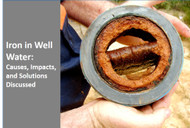Iron in Well Water: Causes, Impacts, and Solutions Discussed
Posted by David Cannon on 11th Aug 2020

Is your well water red in color? Is there iron in your well water? If yes, then isn't it troublesome? It is undeniable that iron is an essential element for the human body but its intake through well water is definitely not a healthy thing. Iron in water can cause several problems, not just for human health but also for skin and objects around us. If you find iron in your well water, then it needs to be removed as soon as possible. Well, for that, you must know what damage iron in water can do to you, what causes this problem, and an effective solution for it. This post guides you through all of it. It discusses the causes, impact, and solutions for iron in well water problem.
Causes of Iron in Well Water Problem
Now that it is acknowledged that iron in water is such a problem, and it needs to be resolved, it is essential to get to the root of the cause. Let us discuss how iron comes in well water.
- Seepage: Often rain or molten snow induces soil migration from higher to lower level surfaces, which is where the wells are located. If the soil contains iron, then it finds its way to the well water. Once the iron from soil dissolves in water, it gets contaminated and comes along with your water supply.
- Corrosion: Wells are integrated with piping and pumps to withdraw water from it and take it for utility. If proper care is not taken, then the pipelines and pump casings get corroded. If the well water is hard, then the chances of corrosion are very high. This rusted iron contaminates well water and travels through water lines to the user.
Impacts of Iron in Water
Since the causes of iron in well water are discussed, it is quite clear that water contaminated with rusted pipeline iron or soil contamination cannot be good for you. Let us discuss what hazards it may cause to the user if consumed or came in direct contact with.
- Health Hazards: According to the United States Environmental Protection Agency (EPA), iron intake via water is secondary contamination which can cause serious health hazards. However, 0.3 milligram iron per liter is a safe iron consumption but if the level exceeds it can be harmful. The iron in water can bring bacteria that feed on iron particles. These bacteria are hard to digest and cause hemochromatosis in one's body. If the intake is heavy and iron saturates in the body, then it can cause dysfunction of the liver, pancreas, and heart and may even lead to diabetes.
- Skin and Hair Damage: Contaminated iron can cause serious damage to the skin as well as hair. It does not blend well with soap therefore, it leaves iron residues on the body which can entrap the pores. Generally, iron in water leads to extensive hair fall, scalp dryness, and skin acne and eczema.
- Stains and Stink: Iron water is red in color. Due to its poor blend-ability with soap, it leaves stains on clothes and utensils. Also due to iron bacteria, it can leave a stringent smell on washed objects.
- Clogged Pipelines: As iron contaminated water passes through the pipelines, it carries several contaminated particles, soil, and sand along with the flow. Iron bacteria feeds on iron particles in water and remaining iron particles cause scaling on the pipelines, Scaling causes clogged pipelines. Since the iron bacterial remains in the water, it is possible to have other microorganisms in water which can drastically drop the quality of water.
- Affects Food Quality: Iron water has a strong smell. Food and beverages must be made in fresh, clean, and purified water. If iron water is used for cooking, it can cause a foul smell in food. Also, need not say via food and beverages, intake of iron can cause serious damage to internal organs.
Solutions for Iron in Well Water Problem
Now that the problem is known, causes are detected, then it is time for a solution. Following are the solutions you can implement to get rid of iron in well water problem.
- Water softening: Water softening can reduce rusting of pipelines, this means iron level in the well water can be reduced by softening.
- Aeration and Oxidized filters: Aeration can help in reducing iron bacteria and iron contamination by iron oxidization. The oxidized filters do the same. Therefore, you can employ aeration or use oxidized filters for reducing iron concentration in the well water.
- Chemical Oxidation: Injecting chlorine or hydrogen peroxide in the well water can oxidize the iron, which makes it easy to get rid of it.
Although these solutions are effective it is essential to use an efficient solution for iron in well water problems. It is important that you source these solutions from trusted companies. Cannon Water Technology, Inc, offers a called the BoreSaver. It is an ultra-iron oxide cleaner solution that features an iron-reducing bacterial treatment. They also offer a range of oxidized filters and water softening solutions to get iron-free water.
